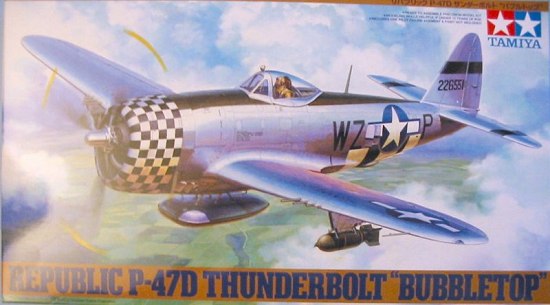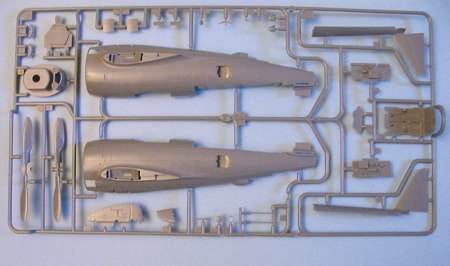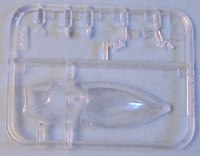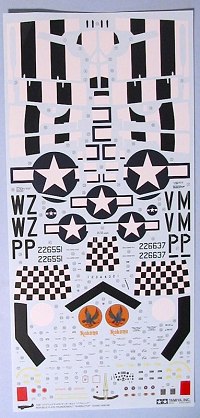
|
KIT: |
Tamiya 1/48 P-47D Thunderbolt |
|
KIT # |
? |
|
PRICE: |
Probably $41.00 |
|
DECALS: |
Two aircraft |
|
REVIEWER: |
|
|
NOTES: |

|
HISTORY |
|
THE KIT |
 |
  |
What can I say? If you've bought the Tamiya P-47 "Razorback," you have a good idea what to expect: clean, crisp molding, accurate outlines, superb engineering to create a kit that can go together in a matter of hours, a kit that a beginner can turn into something wonderful. (Your editor has weaseled out on showing every sprue and concentrated on those that are different. For a look at the other sprues check out Tom's Razorback preview.)
Once again, there is no need of spending money on a resin cockpit (save the cash to by another one of these). The cockpit has all the detail I have ever seen on a P-47 resin cockpit, and goes together easily.
For those who sweat these kinds of details (sorry, I'm not one of them), the engine has been modified to be the version of R-2800 used on the P-47D-25, with the corrected magnetos.
You get the
early "skinny" Curtiss-Electric prop, the later "symmetric" Curtiss-Electric
paddle-blade prop, the Hamilton-Standard prop used on the P-47D-25, and
the later "assymetric" Curtiss-Electric prop. If you don't sweat the
engine, you can make any bubbletop P-47 that didn't have the fin fillet,
i.e., the P-47D-25, the P-47D-27, and the early P-47M. However, the kit
does not have the underwing dive brake, which was on the "M." This could be easily scribed in if that's what you
want to do.
which was on the "M." This could be easily scribed in if that's what you
want to do.
As far as underwing ordnance is concerned, you get a 150-gallon "flat tank" for the centerline, and a choice of the 108-gallon "paper" tanks used in the ETO or the 150-gallon metal tanks used in the Mediterranean and Pacific, as well as 500-lb. bombs and the three-tube "bazooka."
The fuselage has a separate upper rear portion, including the vertical fin; this bodes well for later versions with the fin fillet.
The bubble canopy is properly dimensioned, with the smaller windscreen that Monogram and Academy got wrong. It's a bit thick, and therefore has some optical distortion. This might be solved with Future, but most modelers are not going to pose the canopy closed, so it "machts nichts." The N-3 and Mk. VIII gunshights are provided on the clear sprue.
The decals are standard Tamiya, i.e., thick. However, those modelers who are "D-Day stripe"-challenged will be happy to find a complete set of lower-surface stripes, which will likely go on very easily with a good "timed rolling barrage" of setting solution. The sheet provides an airplane of the 78th Fighter group, and one flown by General Bill Kepner, C.O. of 8th AF Fighter Command in 1944-45. So far as decals are concerned, there is a plethora of great sheets of bubbletop P-47s out there from Aeromaster/Eagle Strike, Superscale and Cutting Edge, to name a few (No kidding, I've reviewed at least two dozen in the last few months alone! Ed). There was likely no other airplane flown in combat in World War II with more interesting and colorful markings than the P-47 bubbletop. Those modelers smart enough to buy 3-4 (or more) of these from HobbyLink Japan at the reasonable "Japanese price" will find plenty of ways to make different airplanes from this great kit.
|
CONCLUSIONS |
This is the kind of kit that is an "ace maker." The newest beginner can follow the instructions and have a well-built model, right out of the box, with a minimum of "sweat." It's the kind of model that allows the modeler to concentrate on all the "fun stuff" - interesting camo, great markings, etc.
It's definitely flown to the top of the "to do" pile here at Le Chateau du Chat. Look for a review "soon."
Thanks to HobbyLink Japan for the review kit.
If you would like your product reviewed fairly and quickly by a site that has over 200,000 visitors a month, please contact me or see other details in the Note to Contributors.